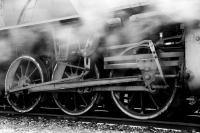








A steam locomotive is a railway locomotive that produces its pulling power through a steam engine. These locomotives are fueled by burning combustible material—usually coal, wood, or oil—to produce steam in a boiler. The steam moves reciprocating pistons which are mechanically connected to the locomotive's main wheels (Drivers). Both fuel and water supplies are carried with the locomotive, either on the locomotive itself or in wagons (tenders) pulled behind. The first steam locomotive was made by Richard Trevithick on the 21st of Feb 1804, two years after the railway locomotive he made in 1802 or the road locomotive he made in 1801.
Steam Engine
The creation of steam locomotives began with the development of the steam engine. The invention of the steam engine dates back into the late 17th century. In 1698, Thomas Savery, an English inventor, patented a device that allowed for the use of steam to pump water. The steam engine that he created was used to remove water from mines. This design was improved upon by English engineer Thomas Newcomen in 1712. Later, further and more significant improvements to the steam engine were made by a Scottish engineer and inventor by the name of James Watt starting in 1763. It was Watt's improvements to the steam engine that opened the door to the invention of steam locomotives.
The Creation of Steam Locomotives
Britain was a major force in the development of the steam engine and steam locomotives. Although prototypes had previously been created, the first full scale steam locomotive was built in Britain by British engineer Richard Trevithick in 1804. Unfortunately his steam locomotive was not well received. In 1814, the first successful steam engine locomotive was built by the British Engineer George Stephenson called Blücher, which could haul up to 30 tons of coal at 4mph going uphill. Later in 1825, Stephenson also created the first public railway for steam locomotives.
The first steam locomotive to run in America, was shipped from Britain. Called the Stourbridge Lion, it was ordered for the purpose of transporting coal. At 7.5 tons, it was too heavy for the tracks which were meant to hold 4 tons. The first steam locomotive to be built in America was the Tom Thumb by Peter Cooper. The Tom Thumb had its first run in 1830, hauled 36 passengers and went 18mph. In 1830, the steam locomotive known as The Best Friend of Charleston was the first locomotive to pull cars in America and regularly carry passengers.
Steam Locomotives Work
The steam powered engine is the heart of the steam locomotive. In order to understand how the locomotive works, it is important to first understand how the steam engine operates. This involves water and fire, which is used to create heat. Coal, or wood is frequently the fuel that is used to create the fire, although oil was also used. The fire is used to heat the water which in turn creates the steam that causes the wheels to turn. Fire tube boilers that were commonly used in steam locomotives here typically built horizontally.
Near the rear of the boiler was the firebox. The firebox is the area on the boiler where the fuel is burned and is made with a door that could be opened to add coal or wood for fuel. The heated gases pass through metal tubes that are submerged in the boiler's water and converts the water into steam. This steam can be released manually if the pressure becomes too high, or it can be released into the steam pipes into a cylinder where it moves the pistons. The pistons are connected to the wheels. As the valves release the steam onto the pistons, the wheels move.
Evolution of Steam Locomotives
From their original conception, the look and the use of steam locomotives evolved significantly. Cow catchers were attached to the front to help the locomotives navigate turns better and to move cows which may have wandered onto the tracks. Originally a means of hauling materials such as coal, stream locomotives quickly became a popular means of passenger transportation. Passenger cars became increasingly convenient and comfortable with luxury features such as sleeping cars. As they evolved, they also became larger and as a result, more powerful and faster. Their two cylinder design evolved into up to four cylinders, which improved their efficiency. Gears were added to certain locomotives that operated on industrial, mining, quarry or logging railways. Over time, starting in the 1930s and ending in the 1950s, diesel and electric trains began to take the place of steam locomotives.
Today Steam Locomotives
Today, most steam locomotives still in operation are for historical, educational or entertainment purposes. Railroad museums have exhibits on the history of steam locomotives, including preserved and maintained steam locomotives. In some cases, they may even offer excursions to the public.